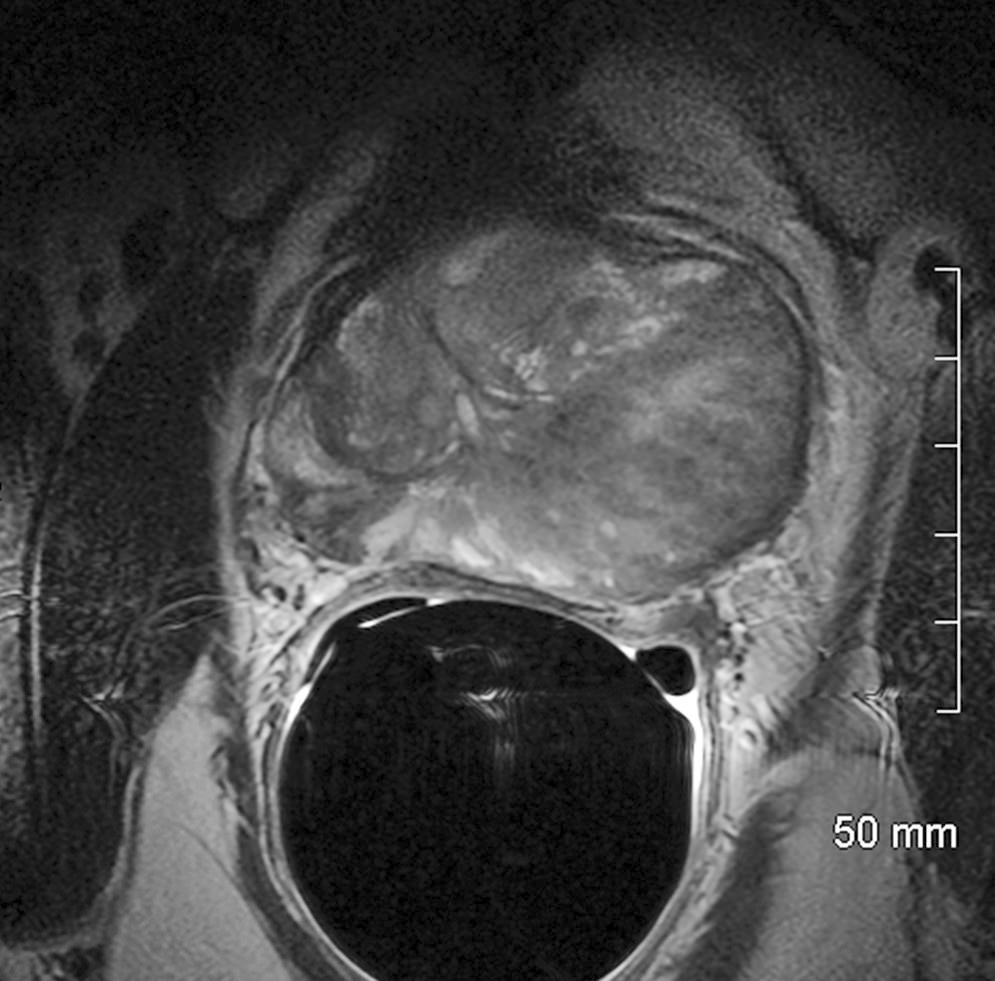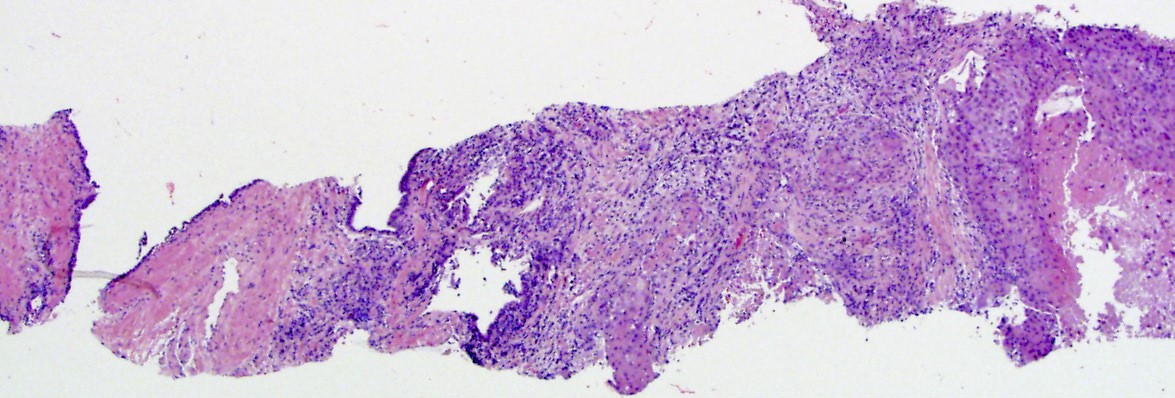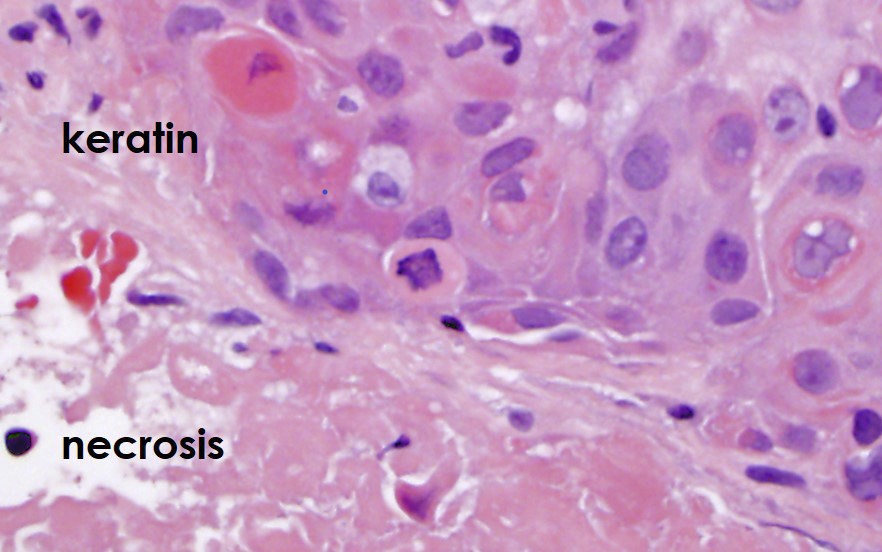Table of Contents
Definition / general | Essential features | Epidemiology | Pathophysiology | Clinical features | Adenosquamous carcinoma | Laboratory | Radiology images | Case reports | Treatment | Gross description | Microscopic (histologic) description | Microscopic (histologic) images | Positive stains | Negative stains | Differential diagnosis | Board review style question #1 | Board review style answer #1 | Board review style question #2 | Board review style answer #2Cite this page: Iczkowski KA. Squamous cell carcinoma. PathologyOutlines.com website. https://www.pathologyoutlines.com/topic/prostatesquamous.html. Accessed April 2nd, 2025.
Definition / general
- Extremely rare; incidence is < 0.6% of all prostate cancers with ~70 cases reported (Rare Tumors 2010;2:e47, Am J Surg Pathol 2004;28:651)
- Most are accompanied by concomitant adenocarcinoma (adenosquamous), generally high grade; some are purely squamous (Am J Surg Pathol 2004;28:651, Case Reports in Clinical Pathology 2016;3:60)
Essential features
- Criteria for diagnosis of pure primary squamous cell carcinoma of the prostate:
- Unequivocal features of malignancy
- Definitive squamous differentiation
- Lack of admixed conventional carcinoma component (would be adenosquamous) (Rare Tumors 2010;2:e47)
- No squamous cell carcinoma elsewhere (Mod Pathol 2004;17:316)
Epidemiology
- Most over age 70 (Cent European J Urol 2014;67:26, Rare Tumors 2010;2:e47, Am J Surg Pathol 2004;28:651)
- In 35/66 cases (over 50%) it arises in the settings of previous radiation or hormonal treatment for prostatic adenocarcinoma (Diagn Pathol 2011;6:46)
Pathophysiology
- Possible origin (J Clin Pathol 1988;41:1288):
- Purely prostatic with transformation of adenocarcinoma
- Collision tumor
- Derived from pluripotent stem cells
- Clonal evolution of adenocarcinoma under pressure from therapy
- After estrogen therapy, glutamine therapy, radiation seed implantation (Prostate Cancer and Prostatic Diseases 2000;3:53)
- Squamous differentiation of a prostatic urethral primary tumor
Clinical features
- Early metastasis to liver, bone and lungs (Rare Tumors 2010;2:e47)
- Does not respond to hormone therapy (Radiat Oncol 2007;2:15)
- Median survival 14 months (Cent European J Urol 2014;67:26)
Adenosquamous carcinoma
- Incidence is < 0.6% of all prostate cancers
- Have normal serum PSA and PSAP levels
- Originates from the periurethral glands or prostatic acinar basal cells
- Either de novo or postradiation or hormonal therapy for ordinary adenocarcinoma
- Micro description: both glandular (acinar) and squamous components
- Negative stains: PSA / PAP
- References: Am J Surg Pathol 1987;11:403, Hum Pathol 1995;26:123, Hum Pathol 1984;15:87BJU Int 2008;102:1369
Laboratory
- Can have normal serum PSA and PSAP (Clin Genitourin Cancer 2014;12:e29)
Case reports
- 55 year old man adenosquamous carcinoma of the prostate (Urology 1999;53:832)
- 57 years old primary squamous cell carcinoma of the prostate (Future Sci OA 2015;1:FSO18)
- 62 year old man with mixed adenocarcinoma, sarcomatoid carcinoma and adenosquamous carcinoma of the prostate (Oncol Lett. 2014 Nov;8(5):2325)
- 65 year old man with squamous cell carcinoma of the prostate following treatment with an LHRH agonist (Cent European J Urol 2014;67:26)
- 67 year old man concomitant adenocarcinoma in the absence of prior androgen deprivation therapy (Case Reports in Clinical Pathology 2016;3:60)
- 73 year old man in which docetaxel therapy was effective (Hinyokika Kiyo 2016;62:259)
- 77 year old man with pure squamous cell carcinoma involving the prostate and urinary bladder (Diagn Pathol 2011;6:46)
- Primary adenosquamous carcinoma of the prostate (Clin Genitourin Cancer 2014;12:e29)
- Long term survival after combined chemoradiation (Radiat Oncol 2007;2:15)
Treatment
- Long term survival has been reported after combined chemoradiation (Cent European J Urol 2014;67:26)
Gross description
- Tends to occur more in transition zone / periurethral (Rare Tumors 2010;2:e47)
Microscopic (histologic) description
- Pure tumors exhibit infiltrating nests, strands and sheets of polygonal cells with nuclear atypia
- Squamous differentiation is manifested as individual cell keratinization, intercellular bridges or keratin pearl formation
Microscopic (histologic) images
Positive stains
- Cytokeratin 34βE12, AE3 (Am J Surg Pathol 2004;28:651, Prostate Cancer and Prostatic Diseases 2000;3:53, Clin Genitourin Cancer 2014;12:e29)
- p53 strong positive consistent with mutation (Oncol Lett 2014;8:2325)
- AMACR may be expressed in adenosquamous areas (maintains an immunohistochemical profile similar to adenocarcinoma) (Diagn Pathol 2011;6:46, Urology 1999;53:832)
Negative stains
- Prostate specific antigen and prostatic acid phosphatase, P501S
- Cytokeratin CAM5.2 (low molecular weight)
- Uroplakin II, S100 protein, CDX2
Differential diagnosis
- Urothelial carcinoma
- Urothelial carcinoma with squamous differentiation
- May be difficult to impossible to differentiate
- Will not have adenosquamous areas
- Squamous carcinoma of other origins such as penis, bladder or anorectal
- Requires clinical and radiologic correlation
- Will not have adenosquamous areas
- Squamous metaplasia
- Can be seen around infarcts within the prostate
- Lacks overt pleomorphism and atypical mitotic figures; does not form a mass
Board review style question #1
What is a finding that may rule out primary pure squamous cell carcinoma of the prostate?
- Negative for low molecular weight cytokeratin
- Negative for prostate specific antigen
- Presence of keratin
- Presence of squamous cell carcinoma elsewhere
Board review style answer #1
Board review style question #2
Which of the following is true about squamous cell carcinoma of the prostate?
- Does not originate adjacent to coexisting squamous metaplasia
- More likely to occur as a focus separate from adenocarcinoma, rather than intermixed and merging with adenocarcinoma
- More often occurs following radiotherapy or antiandrogen therapy than in the absence of those prior therapies
- Serum PSA elevation is useful for diagnosis of the pure form of squamous cell carcinoma
Board review style answer #2
C. More often occurs following radiotherapy or antiandrogen therapy than in the absence of those prior therapies
Comment Here
Reference: Squamous cell carcinoma
Comment Here
Reference: Squamous cell carcinoma












